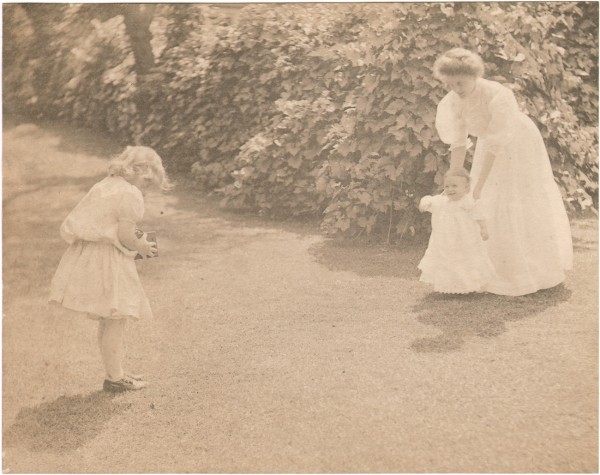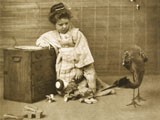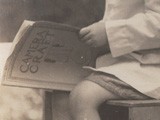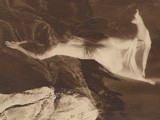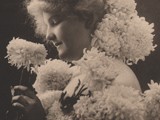1908 Kodak Photographic Advertising Contest First Prize Winner, Amateur Class
PhotographerMrs. W.W. Pearce
CountryUnited States
MediumPlatinum
Year1908
View Additional Information & Tags
Advertising, Children, Contests, Photographers, Photography
Dimensions
Image Dimensions: 15.3 x 19.3 cm
Support Dimensions: None
Associated Blog Posts:
In 1908, the Eastman Kodak Company sponsored an advertising contest for professional as well as amateur photographers. Winning submissions would be used to advertise Kodak products. Mrs. W.W. Pearce, an active woman amateur photographer from Waukegan, IL, won first prize and $300.00 in the Class B Amateur class of the contest. Because of societal norms of the day, it is often difficult to discern the real identity of woman amateurs from this era. Our research indicates however that Mrs. W.W. Pearce was the spouse of three-time Waukegan mayor Dr. William W. Pearce, also a prominent druggist in the town. Federal census records for 1910 list Marian Pearce as the spouse of Dr. W. W. Pearce.
Pearce was the mother of twins (believed to be boys), and we learn of this by an amusing article printed in the Batavia (New York) Daily News:
“Waukegan…boasts of a most unique organization. It is known as the Bachelors’ club, and it has recently come into prominence by reason of a somewhat interesting coincidence. Dr. W. W. Pearce, mayor of Waukegan, was the first president of the Bachelor’s club. About a year ago he offered a ($5?) medal for the member of the club who should first become the father of twins. Much to his own surprise, Mayor Pearce has won his own medal.” 1.
Motherhood apparently did not slow down Mrs. W.W. Pearce. (Marian) She is listed as an exhibitor in the Royal Photographic Society annual exhibitions for 1905 and 1907 as well as the 1909 Dresden International Photographic Exhibition in Germany. She was the author of photographic articles , and photographs of young children, perhaps her own, graced publications such as San Francisco’s Camera Craft, for which she wrote about her experiences using a new platinum paper in 1906:
“I recently had sent me three dozen 8x10 sheets of Sepia Artisti Platinum paper made by the Platinum Manufacturing Company, of Denver. I had seen it advertised in this, my favorite photographic magazine, and had long desired to give it a trial. The opportunity came in my being awarded a prize for one of my pictures, the amount to be taken out in photographic material; and I want to tell of my pleasure at results secured and of the discoveries that I made in using the paper.
In the first place, when the paper arrived I was in violent haste to finish up some exhibition pictures that had to be dispatched at once. The new paper was particularly suited to the work in hand as it was just the size wanted but I had at hand none of the developing salts put out by the manufacturers. All that was available was some old, used developer for black platinums. It was a case of using ”any old thing,” and this was pressed into service: not only this disregard of fairness to the new paper but I heated up the bath as well. The resultant prints were surprisingly fine: such beautiful golden sepia tones such as one sometimes secures with other brands after using an extra amount of sepia solution. I was simply surprised at the fine results. And I did not follow directions in the making up of the clearing bath. Having no hydrochloric acid at hand I made up the clearing bath with muriatic acid instead.
But my discoveries: the first was that I had to rush the sepia prints through the acid baths, giving about five minutes to each, or I lost the beautiful golden glow which I so much desired to retain. This might not have been the case had I followed the maker’s instructions and used the hydrochloric acid advised for the clearing baths. My second discovery was that I could save all my over-exposed prints, no matter how badly over-printed, by simply allowing them to remain in my muriatic acid clearing bath for a half hour or longer. Of course I lost my beautiful golden sepia color but the prints were far from being bad looking platinums. They suffered only by comparison with the correctly exposed ones and for some subjects would have withstood even that strong test as to their quality. The last discovery was that this bleaching or reducing effect could be best secured while the prints were wet. Some over-exposed prints had been allowed to dry and were treated to the acid bath the next day. These required about twenty four hours in which to become reduced to good prints.
I do not wish to recommend such total disregards of the maker’s instructions. I have described my experience with this paper only because I feel that the results of actual experiments are valuable to other workers. I am sending for a supply of the maker’s developing salts and shall employ the acid recommended by them when next using the paper. With me it was a case of using what I had at hand and to say that I was agreeably surprised at the fine results secured is stating the case very mildly.” 2.
Details for the 1908 Kodak Advertising Contest for which Pearce went on to win first place for this photograph appeared in many photographic journals of the era, including the Photographic Times early in the year. It is interesting to note Kodak marketed the contest in 1908 as a way for them to replace paintings by soliciting photography in their advertising efforts:
1908 Kodak Advertising Contest.—$1,600.00 in cash prizes; $1,000.00 in the Professional Class; $600.00 in the Amateur Class. In our last year’s Photographic Advertising Contest we offered as a first prize one thousand dollars for the three best negatives, 8x10 or larger, to be used in advertising the Kodak. It was our idea that we could secure photographs which would be better for camera advertising than anything we had had in the way of paintings. We believe that the results of this contest showed our ideas to be correct. Relatively we are offering more in the 1908 contest than in the previous one. The first prize for one negative in the Professional Class is to be $500.00. This is more money than we have ever paid for a painting for advertising purposes and should bring out good work—work that is not only good from the photographic but from the advertising standpoint.
Pictures which are simply good photographs and contain nothing showing the use or the pleasures of the Kodak system of photography are of course valueless from an advertising standpoint. What we need are pictures that forcefully and pleasingly drive home the Kodak idea, and for these we are willing to pay liberally.
We expect, through this and similar contests to not only secure valuable material for our own advertising, but to demonstrate still further the great possibilities that await the photographer in the illustrative field.
TERMS.
1. Each picture is to contain a figure or figures and is to be suitable for use as an illustration in advertising the Kodak or the Kodak system of amateur photography.
2. Each print in Class “A” must be from a negative 5 x 7 or larger. Each print in Class “B” must be from a negative 4 x 5 or 3 ¼ x 5 ½ or larger.
3. Prints only are to be sent for competition—not negatives.
4. Prints must be mounted but not framed. (Mounts should show about one inch margin.)
5. No competitor will be awarded more than one prize. (This does not prevent a competitor from entering as many pictures as he may desire.)
6. Due and reasonable care will be taken of all non-winning prints and, barring loss or accident, they will be returned to their owners at our expense, but we assume no responsibility of loss or damage.
7. The negatives from which all prizes winning prints are made are to become the property of the Eastman Kodak Co., and are to be received by it in good order before payment of prize money is made.
8. Contestants who are awarded prizes must also furnish to us the written consent of the subject (in the case of a minor, the written consent of a parent or guardian) to the
use of the picture in such manner as we may see fit in our advertising.
9. All entries should be addressed to Eastman Kodak Co., Advertising Department, Rochester, N. Y.
10. In sending pictures, mark the package plainly, “Kodak Advertising Contest,” and in the lower lefthand corner write you own name and address. Then write us a letter as follows:
I am sending you to-day by Mail, Express,
charges prepaid, prints. Please enter in
your Kodak Advertising Competition. Class. Yours truly,
Name,
Address,
11. The name and address of the competitor must be legibly written on a paper and enclosed in a sealed envelope in the same package in which the prints are forwarded. There is to be no writing on prints or mounts.
12. We will promptly acknowledge the receipt of pictures, and .when awards are made, will send each competitor a list of prize winners.
13. Only recognized professional photographers conducting a studio will be allowed to compete in Class “A.” Class “B” is open to all photographers not in above classification.
14. This contest will close October 1st, 1908.
THE PRIZES.
Class A. Professional Photographers only. Negatives 5 x 7 or Larger.
First Prize $500.00
Second Prize 250.00
Third Prize 125.00
Fourth Prize 75.00
Fifth Prize 50.00
$1,000.00 Class B. Amateurs only. Negatives 4 x 5 or 3 ¼ x 5 ½ or Larger.
First Prize $300.00
Second Prize 150.00
Third Prize 75.00
Fourth Prize 50.00
Fifth Prize 25.00
_________________
$600.00
Suggestions.
The jury will be instructed to award the prizes to those contestants whose pictures, all things considered, are best adapted to use in Kodak (or Brownie Camera) advertising.
As reproductions of the pictures will often be in small sizes, too much detail should not be introduced.
Pictures for reproduction should be snappy —vigorous, for they lose much by the halftone process.
Where apparatus is introduced, it must be up-to-date. If you haven’t the goods, you can borrow.
There may be possibilities in introducing the Kodak Tank Developer idea.
It is highly probable that we shall want to secure some negatives aside from the prize winners. In such cases special arrangements will be made.
THE JUDGES.
The jury of award will consist of photographers and of advertising men who are fully competent to pass upon the work submitted. Full attention will be paid therefore to the artistic and technical merit of the work as well as to its strength from an advertising standpoint. Announcement of the names of the judges will be made later.
Eastman Kodak Co.,
Rochester, N. Y. 3.
The judges worked quickly in the month of October, 1908 for entries submitted in both professional and amateur classes. Their decisions appeared in Buffalo’s Professional and Amateur Photographer the following month:
Professional Photographer Publishing Co., Buffalo, N. Y. October 29, 1908
Gentlemen : We take pleasure in giving you below the results of our 1908 Kodak Photographic Advertising contest. The prize winners were :
Class A. Professional Photographers Only.
H. E. Lawson, New York City. First Prize, $500.00
F. & C. A. Maynard, Philadelphia, Pa. Second Prize, 250.00
Geo. L Gilbert, Burlington, la. Third Prize, 125.00
Mrs. Gertrude Cockroft, Alameda, Cal. Fourth Prize, 75.00
Rudolf Eickemeyer, New York City. Fifth Prize, 50.00
Class B Amateurs Only.
Mrs. W. W. Pearce, Waukegan, Ill. First Prize, $300.00
R. P. DeVault, Battle Creek, Mich. Second Prize, 150.00
H. B. Conyers, Urbana, Ohio, Third Prize, 75.00
H. V. Roberts, Utica, N. Y. Fourth Prize, 50.00
W. S. Ludden, Schenectady, N. Y. Fifth Prize, 25.00
The judges were Mr. A. F. Bradley, of New York City; Mr. Elias Goldensky, of Philadelphia ; Mr. J R. Mix, advertising manager of Scribner’s Magazine ; Mr. Robert Frothingham, advertising manager of Everybody’s Magazine, and Mr. H. S. Houston, advertising manager of World’s Work and Country Life in America.
Yours truly,
EASTMAN KODAK COMPANY,
L. B. Jones,
Advertising Manager. 4.
In unknown hand on print verso: Mrs Pierce - Waukegan Illinois $300 prize
Subjects in photograph including young girl taking photograph with Kodak Brownie camera at left are unknown at this time.
1. Matrimony By Ballot: in: The Daily News: Batavia, New York: Saturday, March 11, 1899.
2. Sepia Artisti Platinum: By Mrs. W. W. Pearce in: Camera Craft: A Photographic Monthly: Camera Craft Publishing Company: San Francisco: Vol. XIII, July, 1906: p. 247
3. Items of Interest: in: The Photographic times: An Illustrated Monthly Magazine Devoted to the interests of Artistic and Scientific Photography: Edited by W.I. Lincoln Adams and Charles H. Plump: New York: The Photographic Times Publishing Association: Volume XL, February, 1908: pp. 63-64
4. Notice: in: The Professional and Amateur Photographer- A Journal of Practical Photography: Professional Photographer Publishing Co.: Buffalo: November, 1908: Vol. XIII: p. 472
